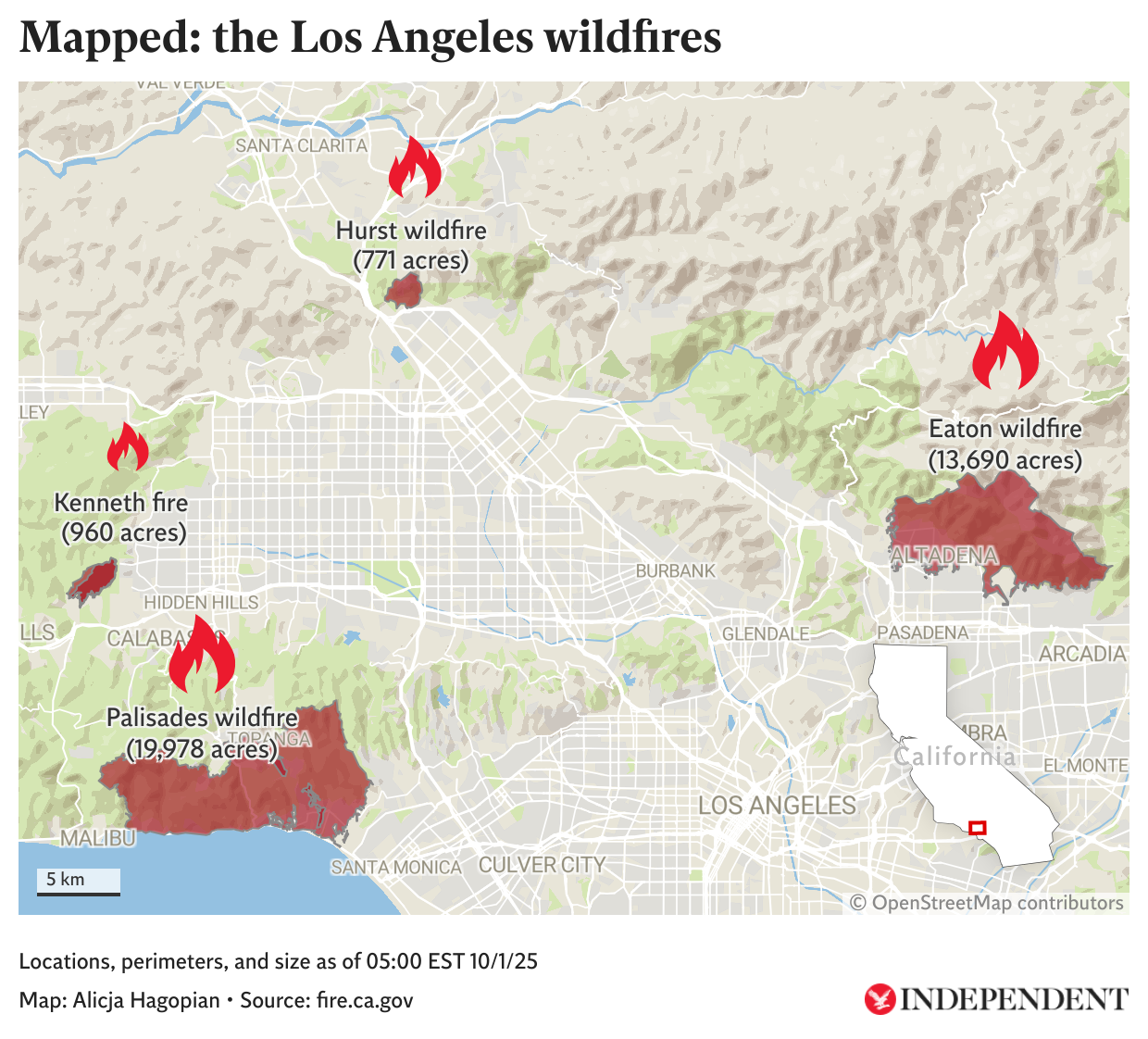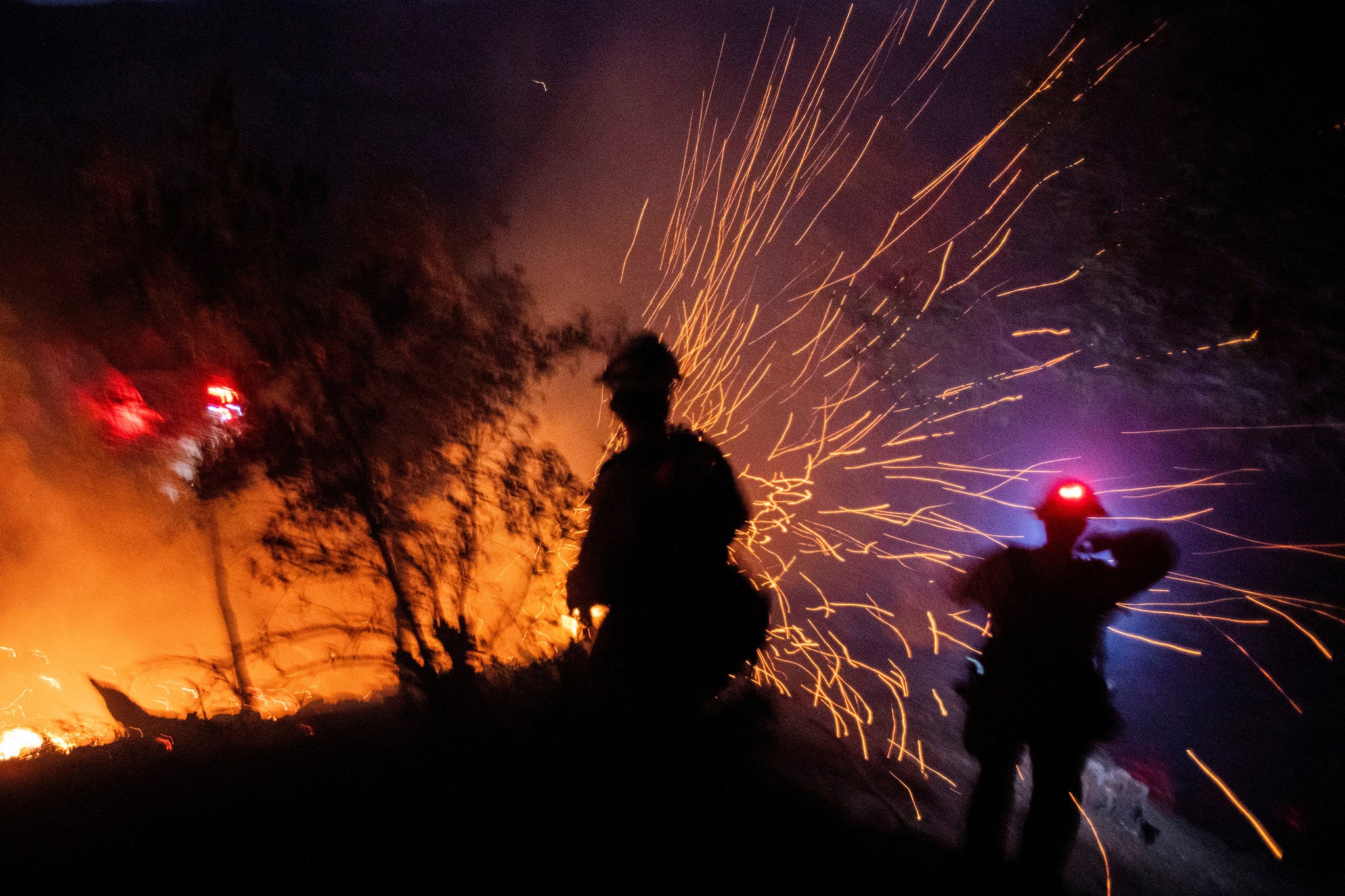Wildfires ravaging Los Angeles have killed at least 10 people and destroyed nearly 10,000 structures, with five fires burning into a third night.
The Palisades Fire between Santa Monica and Malibu on the city’s western flank and the Eaton Fire in the east near Pasadena already rank as the most destructive in Los Angeles history, consuming more than 53 square miles, turning entire neighbourhoods to ash.
The death toll from the blazes rose to 10, Los Angeles County’s Medical Examiner said on Thursday night. Los Angeles County Sheriff Robert Luna said earlier he expected the number to grow.
“It looks like an atomic bomb dropped in these areas. I don’t expect good news, and we’re not looking forward to those numbers,” Mr Luna said.
Private forecaster AccuWeather estimated the damage and economic loss at $135 billion to $150 billion, warning of a difficult recovery and soaring homeowners’ insurance costs.
President Joe Biden, who declared a major disaster on Tuesday, promised on Thursday that the federal government would reimburse 100% of the recovery for the next 180 days to pay for debris and hazard material removal, temporary shelters and first responder salaries.
Where are the fires currently burning?

In all, five wildfires burned in Los Angeles County, with the largest Palisades fire just 6% contained and the Eaton fire 0% contained. Skies buzzed with aircraft dropping retardant and water on the flaming hills.
A large Super Scooper aircraft on loan from Canada was damaged and grounded after hitting an unauthorized civilian drone near the Palisades fire, the L.A. County Fire Department said. There were no injuries.
One rapidly growing blaze broke out on Thursday near Calabasas, one of the wealthiest cities in the U.S. and home to numerous celebrities and gated communities. The so-called Kenneth Fire expanded to 960 acres (388 hectares) in a matter of hours.
Officials said the Eaton Fire had damaged or destroyed 4,000 to 5,000 structures while the Palisades Fire destroyed or damaged another 5,300 structures.

Some Pacific Palisades residents ventured back to areas the fire had already swept through, where brick chimneys were left looming over charred waste and burnt-out vehicles.
Winds dropped on Thursday from the 100-mile-per-hour (160-kph) gusts seen earlier in the week, permitting crucial aerial support for crews on the ground.
Firefighting crews managed to fully control the Sunset Fire in the Hollywood Hills, after flames had raged atop the ridge overlooking Hollywood Boulevard’s Walk of Fame on Wednesday night.
Where could the wildfire move to next?
Meteorologists at private forecaster AccuWeather said winds on Friday are not expected to be as strong as they were earlier this week during the windstorm. Wind gusts of 40-50 miles per hour are possible in some areas of Southern California on Friday.
Offshore winds are expected to pick up again Sunday in advance of another area of low pressure that will move south through California, the forecaster said.

Meteorologists added another Santa Ana wind event is possible early next week, which could lead to another extreme fire risk.
AccuWeather predicts wind gusts of 40-60 mph starting Monday through Tuesday night.

Jonathan Porter, Chief Meteorologist at AccuWeather, said the wildfire disaster in Southern California is the latest multi-billion-dollar weather disaster in the United States that is straining state and federal firefighting and emergency resources.
“Many parts of the world face serious impacts and threats from our warming climate and changes to extreme weather patterns. California is on the forefront of climate change in the United States, and this tragic disaster is the latest in a devastating series of extreme weather events resulting in multi-billion-dollar disasters,” Mr Porter said.
Live: evacuation order areas in Los Angeles County
What is causing the fires?
The fast-moving wildfires are being fueled by a weather phenomenon known as the Santa Ana winds.
The Santa Anas are dry, warm and gusty northeast winds that blow from Nevada and Utah to Southern California toward the coast. They move in the opposite direction of the normal onshore flow that carries moist air from the Pacific into the region.
The name is understood to be linked to Santa Ana Canyon in Orange County, but the weather has other nicknames such as “devil winds” or “red wind.”
LAFD officials said they are bracing themselves for the bruising winds to reach gusts of up to 60 mph through Thursday. In some mountainous regions of south California, the Santa Ana winds reached speeds of up to 100 mph, according to the National Weather Service.
The weather service has issued an extreme weather warning of a life-threatening and destructive windstorm for some areas.



